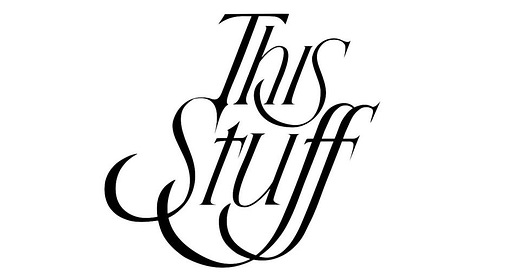Welcome to THIS STUFF 2.0. Before we get to the story this week there are some updates! Not much has changed regarding the look and feel, but here's what will be different.
Frequency - I’ll send out a newsletter once a week, every Wednesday.
New Media - I'm going to try some new things with audio, photos and video, so stay tuned for more interactive stories.
Style - Some weeks, the newsletter will include one big story like today; in others, it will have a theme with multiple pieces to accompany it.
Discussions - During significant fashion events like Fashion Week and the Met Gala, I will have a live conversation that you can join.
Last week, artist Banksy accused Guess of stealing his art for their storefront in London. In a post, the artist wrote, "They've helped themselves to my artwork without asking, how can it be wrong for you to do the same to their clothes?"
Though it appears Guess obtained the work legally through a third party called Brandalised (which has a license to sell Banksy memorabilia), the call out raises a more significant point about a bad habit of the industry: fashion loves to take.
For decades, brands from luxury to fast fashion have been accused of ripping off designs and artwork from independent artists on the internet. One designer claimed Jeremy Scott copied their work for a Moschino collection in 2018 (Scott later denied the claims). 12 artists accused Zara of using their work on pieces in 2016, and Shein has had countless call outs for copying the work of artists. The practice is almost routine at this point, with a considerable complication being the complexities of copyright law. The recourse for most people who have been stolen from is the hope that public outcry will at least remove the products. Rarely is there any payment or even acknowledgment that the wrongdoing was more than just a silly mistake.
Fashion is big business – the industry is worth over 1.7 trillion dollars. It does not have a moral compass. While artistry and craftsmanship may be part of the equation, ultimately, like all businesses, the goal is to make money. And it's often done through theft at every juncture. Textiles come from farms that use forced labor – Shein was recently accused of using Xinjiang cotton for example. Wages are stolen from workers in factories, who are paid per item they make instead of by the hour. The brands use sophisticated algorithms to rip off popular outfits and trends on social media. And, of course, sometimes brands are blatantly stealing the work of an artist to put on a t-shirt.
It’s not always obvious, but somewhere along the line (especially when it comes to cheap clothing) labor, wages, art or something else was stolen.
Interestingly, though, many of these brands go above and beyond to ensure they are not being copied. Brands have legal teams that sue counterfeiting rings and sellers, and they create proprietary technology so that another brand cannot copy designs and processes. At the end of the day, it's often about making more money and hoping no one sees how you did it. In many ways, stopping this practice is a game of whack-a-mole but that doesn’t mean we shouldn’t talk about it.
Banksy has a massive audience, and so the message was made loud and clear. Most times, though, workers and artists are screaming into a void.
******************************************************************************
Thank you for reading!!
This Stuff is a newsletter by me! fashion journalist, Alyssa Hardy. Three times a week, I unpack the ways our clothes impact the world through news, essays, interviews and more. Subscribe for free here and follow me on Instagram and Twitter.
You can order my book "Worn Out: How Our Clothes Cover Up Fashion's Sins" here.






